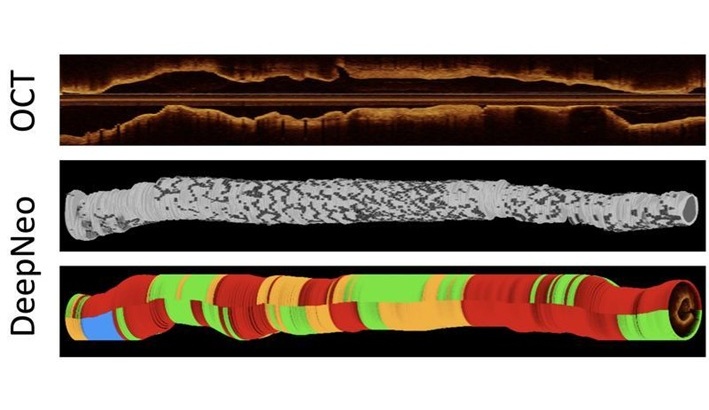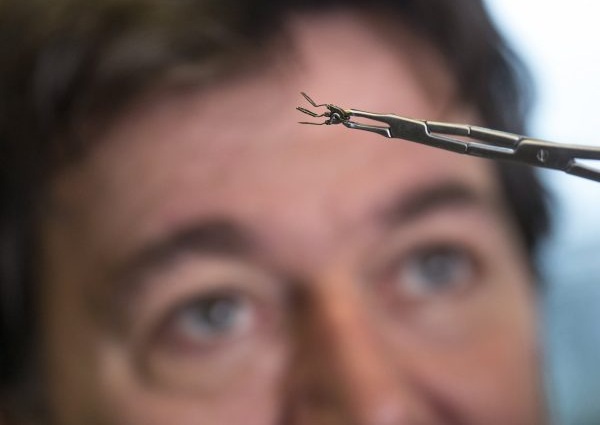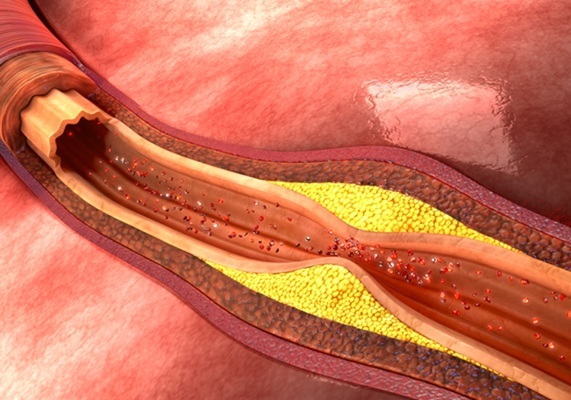Therapeutic Device Reduces Disability Following Stroke
|
By HospiMedica International staff writers Posted on 22 Feb 2021 |

Image: Low intensity electromagnetic fields can assist recovery from stroke (Photo courtesy of BrainQ)
Artificial intelligence (AI) powered therapy generates electromagnetic fields that enhance recovery and reduce disability caused by ischemic stroke.
The BrainQ (Jerusalem, Israel) BQ System is a cloud-connected wearable device that delivers extremely low frequency low intensity electromagnetic fields (ELF-EMF), tailored to the individual patient. By measuring several electrophysiology measures, such as electroencephalography (EEG), electromyography (EMG), and magnetoencephalography (MEG), which characterize the neural oscillatory activity, the device can deliver the neuromodulatory ELF-EMF therapy at specific frequencies to influence these oscillations and aid neurorecovery.
The BQ System extends the window of opportunity for stroke treatment from several hours during the acute phase to days and even weeks in the sub-acute phase following stroke. The effect of ELF-EMF on recovery from neurological conditions include evidences of changes in calcium signaling, which is known to influence and mediate nearly all cellular processes; proliferation, as well as differentiation, of multiple cell types (including neurogenesis of neural stem cells); peripheral nerve regeneration; effects on polar molecules, likely responsible for the development of the neural projections; and changes in plasticity-related growth factor levels in humans.
“Stroke is a debilitating condition with limited recovery options, creating a huge unmet need in the United States. Covid-19 has only made things worse by limiting patients' access to treatment facilities,” said Yotam Drechsler, CEO and co-founder of BrainQ. “We are on the verge of a new era where AI- based precision medicine will be used to treat neurodisorders, which do not have a sufficient solution to date.”
Neuroplasticity describes the ability of neural networks in the brain to change through growth and reorganization. These changes range from individual neuron pathways making new connections, to systematic adjustments like cortical remapping. Neuroplasticity was once thought to exist only during childhood, but research has shown that activity-dependent plasticity, which can manifest even in adulthood, can have significant implications for recovery from brain damage.
Related Links:
BrainQ
The BrainQ (Jerusalem, Israel) BQ System is a cloud-connected wearable device that delivers extremely low frequency low intensity electromagnetic fields (ELF-EMF), tailored to the individual patient. By measuring several electrophysiology measures, such as electroencephalography (EEG), electromyography (EMG), and magnetoencephalography (MEG), which characterize the neural oscillatory activity, the device can deliver the neuromodulatory ELF-EMF therapy at specific frequencies to influence these oscillations and aid neurorecovery.
The BQ System extends the window of opportunity for stroke treatment from several hours during the acute phase to days and even weeks in the sub-acute phase following stroke. The effect of ELF-EMF on recovery from neurological conditions include evidences of changes in calcium signaling, which is known to influence and mediate nearly all cellular processes; proliferation, as well as differentiation, of multiple cell types (including neurogenesis of neural stem cells); peripheral nerve regeneration; effects on polar molecules, likely responsible for the development of the neural projections; and changes in plasticity-related growth factor levels in humans.
“Stroke is a debilitating condition with limited recovery options, creating a huge unmet need in the United States. Covid-19 has only made things worse by limiting patients' access to treatment facilities,” said Yotam Drechsler, CEO and co-founder of BrainQ. “We are on the verge of a new era where AI- based precision medicine will be used to treat neurodisorders, which do not have a sufficient solution to date.”
Neuroplasticity describes the ability of neural networks in the brain to change through growth and reorganization. These changes range from individual neuron pathways making new connections, to systematic adjustments like cortical remapping. Neuroplasticity was once thought to exist only during childhood, but research has shown that activity-dependent plasticity, which can manifest even in adulthood, can have significant implications for recovery from brain damage.
Related Links:
BrainQ
Latest Patient Care News
- Portable Biosensor Platform to Reduce Hospital-Acquired Infections
- First-Of-Its-Kind Portable Germicidal Light Technology Disinfects High-Touch Clinical Surfaces in Seconds
- Surgical Capacity Optimization Solution Helps Hospitals Boost OR Utilization

- Game-Changing Innovation in Surgical Instrument Sterilization Significantly Improves OR Throughput
- Next Gen ICU Bed to Help Address Complex Critical Care Needs
- Groundbreaking AI-Powered UV-C Disinfection Technology Redefines Infection Control Landscape
- Clean Hospitals Can Reduce Antibiotic Resistance, Save Lives
- Smart Hospital Beds Improve Accuracy of Medical Diagnosis
- New Fast Endoscope Drying System Improves Productivity and Traceability
- World’s First Automated Endoscope Cleaner Fights Antimicrobial Resistance
- Portable High-Capacity Digital Stretcher Scales Provide Precision Weighing for Patients in ER
- Portable Clinical Scale with Remote Indicator Allows for Flexible Patient Weighing Use
- Innovative and Highly Customizable Medical Carts Offer Unlimited Configuration Possibilities
- Biomolecular Wound Healing Film Adheres to Sensitive Tissue and Releases Active Ingredients
- Wearable Health Tech Could Measure Gases Released From Skin to Monitor Metabolic Diseases
- Wearable Cardioverter Defibrillator System Protects Patients at Risk of Sudden Cardiac Arrest
Channels
Critical Care
view channel
AI Model Analyzes Patient Data to Diagnose Multiple Sclerosis With 90% Accuracy
Multiple sclerosis (MS) is a chronic inflammatory condition affecting the central nervous system. Most patients initially experience the relapsing-remitting form (RRMS), characterized by periods of symptom... Read more
Magnetically Navigable Microparticles Enable Targeted Drug Delivery
Abdominal aortic aneurysms (AAA) can be life-threatening if not treated and result in nearly 10,000 deaths annually. Researchers working to improve treatments for AAA could now make it possible for doctors... Read more
AI-Powered Algorithm Automates Analysis of Coronary Stents After Implantation
Every year, over three million people globally receive stents to open blocked blood vessels caused by heart disease. However, monitoring the healing process after stent implantation remains a significant challenge.... Read moreSurgical Techniques
view channel
DNA Origami Improves Imaging of Dense Pancreatic Tissue for Cancer Detection and Treatment
One of the challenges of fighting pancreatic cancer is finding ways to penetrate the organ’s dense tissue to define the margins between malignant and normal tissue. Now, a new study uses DNA origami structures... Read more
Pioneering Sutureless Coronary Bypass Technology to Eliminate Open-Chest Procedures
In patients with coronary artery disease, certain blood vessels may be narrowed or blocked, requiring a stent or a bypass (also known as diversion) to restore blood flow to the heart. Bypass surgeries... Read more
Intravascular Imaging for Guiding Stent Implantation Ensures Safer Stenting Procedures
Patients diagnosed with coronary artery disease, which is caused by plaque accumulation within the arteries leading to chest pain, shortness of breath, and potential heart attacks, frequently undergo percutaneous... Read more
World's First AI Surgical Guidance Platform Allows Surgeons to Measure Success in Real-Time
Surgeons have always faced challenges in measuring their progress toward surgical goals during procedures. Traditionally, obtaining measurements required stepping out of the sterile environment to perform... Read moreHealth IT
view channel
Printable Molecule-Selective Nanoparticles Enable Mass Production of Wearable Biosensors
The future of medicine is likely to focus on the personalization of healthcare—understanding exactly what an individual requires and delivering the appropriate combination of nutrients, metabolites, and... Read more
Smartwatches Could Detect Congestive Heart Failure
Diagnosing congestive heart failure (CHF) typically requires expensive and time-consuming imaging techniques like echocardiography, also known as cardiac ultrasound. Previously, detecting CHF by analyzing... Read moreBusiness
view channel
Expanded Collaboration to Transform OR Technology Through AI and Automation
The expansion of an existing collaboration between three leading companies aims to develop artificial intelligence (AI)-driven solutions for smart operating rooms with sophisticated monitoring and automation.... Read more
















